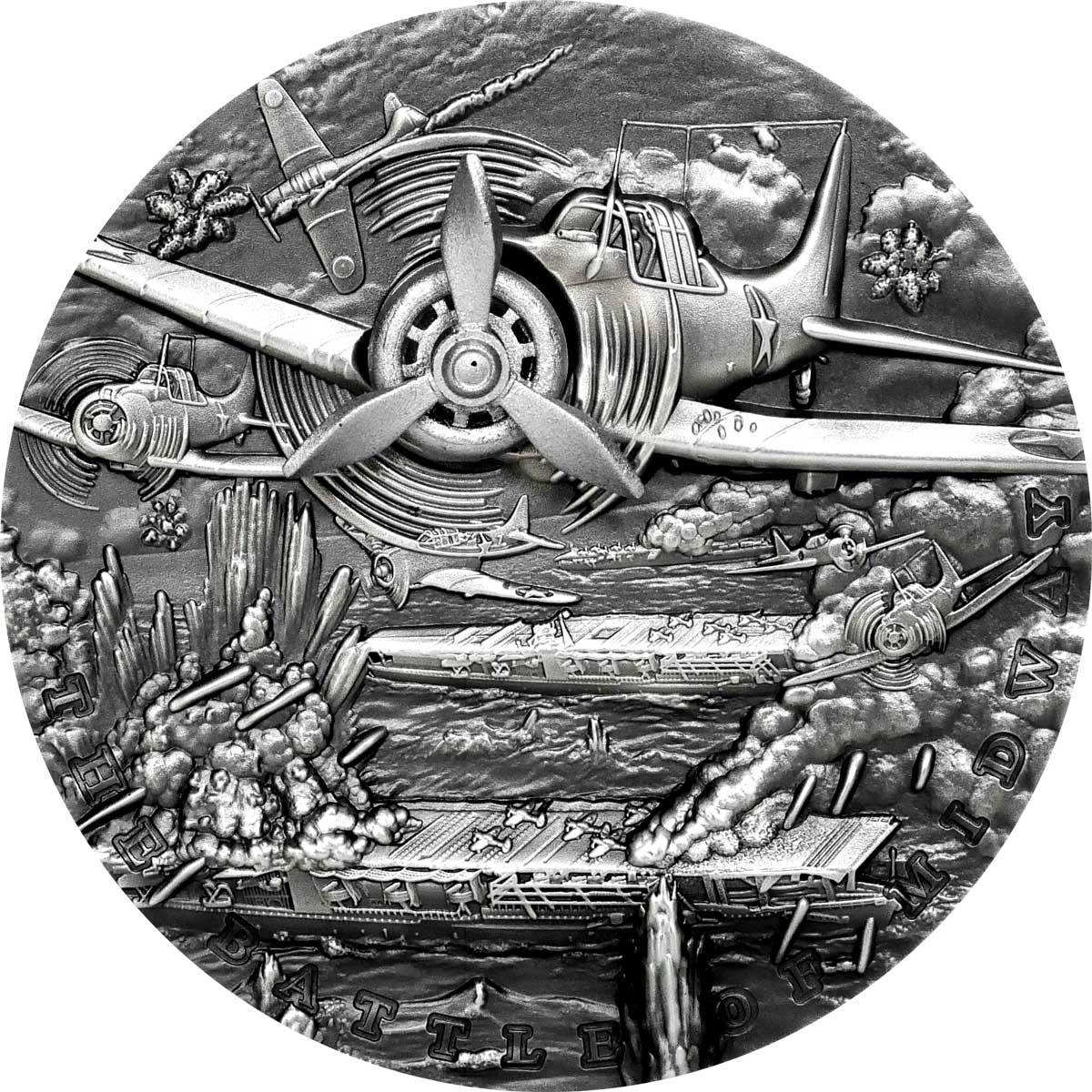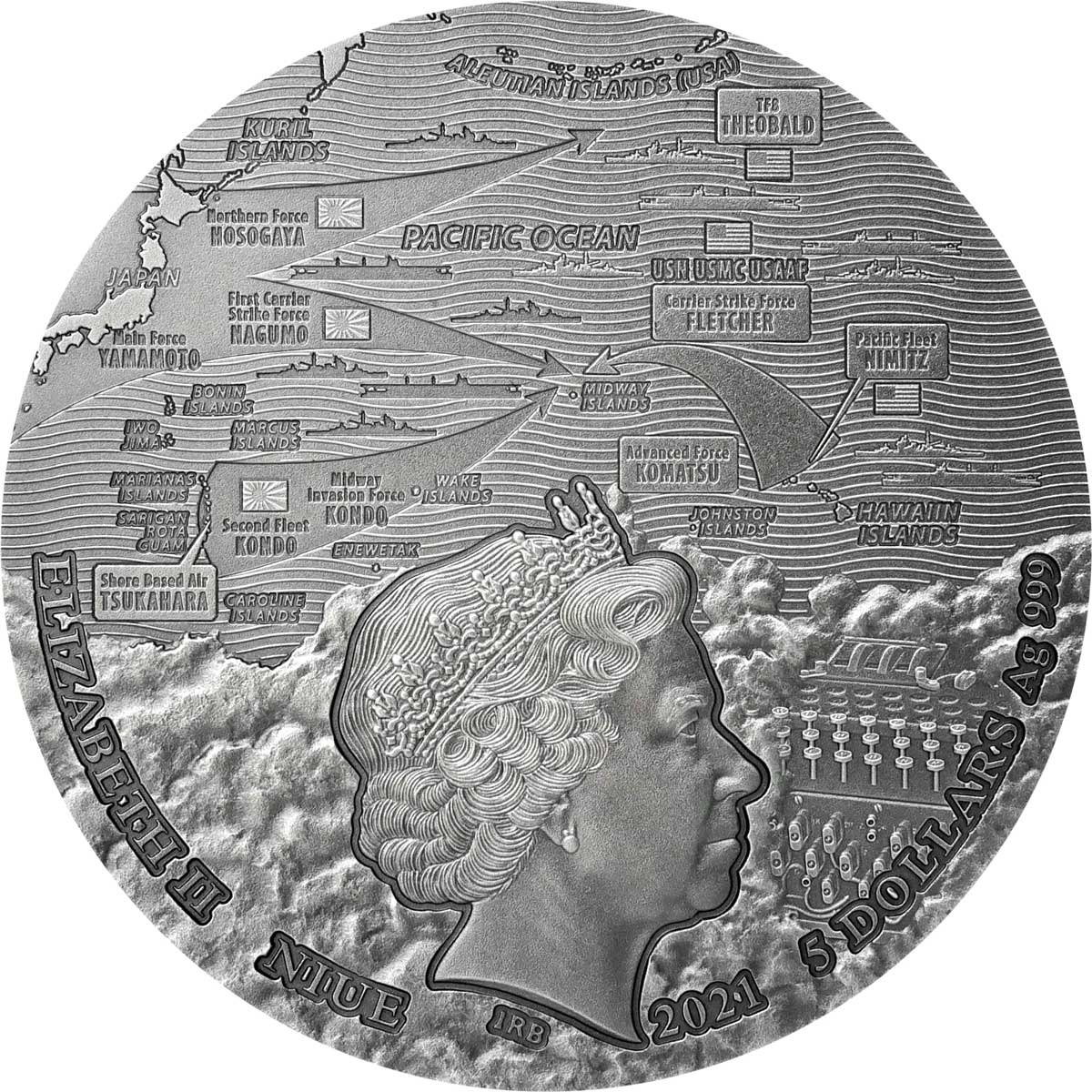The pivotal Second World War Battle of Midway is the second in the Sea Battles series of silver coins
One of the Mint of Gdańsk’s many ongoing antiqued coin series, ‘Sea Battles’ sees its second release, following the pivotal ancient Battle of Salamis with the equally pivotal Battle of Midway, arguably one of the most important battles in the Pacific theatre in World War 2. A sea battle fought over the horizon, almost entirely with aircraft, it ultimately turned the tide against the Imperial Japanese Navy, when it broke the back of their carrier forces, which they were unable to replace easily.
To say this two-ounce, high-relief silver coin is packed to the rim with action, would be a decided understatement. Aircraft in the foreground, aircraft in the background, aircraft carriers on the sea, and explosions everywhere, you can’t accuse the designer of skimping out on the detail. There really is no confusion on just what this coin is about.
Pride of place goes to a US dive-bomber, fairly reminiscent of a Douglas Dauntless, just after it had dropped its load. The gimmick here is the engine cowling and the propeller, both of which are additions to the base strike, and the latter of which is rotatable. For us, it’s the only downside to the coin, a little too gimmicky on a design that doesn’t really need it. It’s certainly different, and we like that, of course, but it will divide opinions. There’s enough overall to make this a fine release, if, like me, military history is your thing.
Like the Salamis coin, the obverse continues the theme, with another of those excellent maps showing the order of battle, and in amongst the smoke, a cypher machine used by code-breakers to get advanced knowledge of Japanese plans. The coin will come boxed with a Certificate of Authenticity and has a mintage of 500 pieces. Available to order now either directly from the mint, or through their various stockists around the world. Check out our where to buy page for some of them.
THE BATTLE OF MIDWAY
The Battle of Midway was a major naval battle in the Pacific Theater of World War II that took place on 4–7 June 1942, six months after Japan’s attack on Pearl Harbor and one month after the Battle of the Coral Sea. The U.S. Navy under Admirals Chester W. Nimitz, Frank J. Fletcher, and Raymond A. Spruance defeated an attacking fleet of the Imperial Japanese Navy under Admirals Isoroku Yamamoto, Chūichi Nagumo, and Nobutake Kondō north of Midway Atoll, inflicting devastating damage on the Japanese fleet. Military historian John Keegan called it “the most stunning and decisive blow in the history of naval warfare”, while naval historian Craig Symonds called it “one of the most consequential naval engagements in world history, ranking alongside Salamis, Trafalgar, and Tsushima Strait, as both tactically decisive and strategically influential”.
Hoping to lure the American aircraft carriers into a trap and occupying Midway was part of an overall “barrier” strategy to extend Japan’s defensive perimeter, in response to the Doolittle air raid on Tokyo. This operation was also considered preparatory for further attacks against Fiji, Samoa, and Hawaii itself. The plan was undermined by faulty Japanese assumptions of the American reaction and poor initial dispositions. Most significantly, American cryptographers were able to determine the date and location of the planned attack, enabling the forewarned U.S. Navy to prepare its own ambush.
Four Japanese and three American aircraft carriers participated in the battle. The four Japanese fleet carriers—Akagi, Kaga, Sōryū, and Hiryū, part of the six-carrier force that had attacked Pearl Harbor six months earlier—were sunk, as was the heavy cruiser Mikuma. The U.S. lost the carrier Yorktown and the destroyer Hammann, while the carriers USS Enterprise and USS Hornet survived the battle fully intact.
After Midway and the exhausting attrition of the Solomon Islands campaign, Japan’s capacity to replace its losses in matériel (particularly aircraft carriers) and men (especially well-trained pilots and maintenance crewmen) rapidly became insufficient to cope with mounting casualties, while the United States’ massive industrial and training capabilities made losses far easier to replace. The Battle of Midway, along with the Guadalcanal campaign, is widely considered a turning point in the Pacific War. (Wikipedia)
| SPECIFICATION | |
| DENOMINATION | $5 NZD (Niue) |
| COMPOSITION | 0.999 silver |
| WEIGHT | 62.2 grams |
| DIMENSIONS | 45.0 mm |
| FINISH | Antique |
| MODIFICATIONS | High-relief, rotating propeller |
| MINTAGE | 500 |
| BOX / C.O.A. | Yes / Yes |






“Action coin” type, we’d say for this unique concept coin. Multiple dynamic effects on one coin. Nice job! 👍
Beautiful and innovative. Great picture of history. The numismatic world will never stop surprise me, especially Mint of Gdansk.